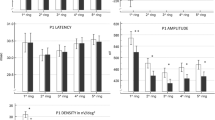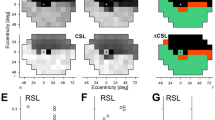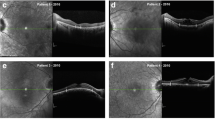Abstract
A hydrolysate of yeast RNA (ENCAD) is used in the Soviet Union for the treatment of hereditary retinal degenerations. We report longitudinal data from three young patients who have made at least two visits to the Soviet Union over a five-year period to receive treatment with ENCAD. Two children were diagnosed with cone-rod degeneration and the third has an isolated (simplex) form of retinitis pigmentosa. Visual function measurements were obtained before and after each visit to Moscow. In the comparison of previsit and postvisit visual acuity, 30 Hz flicker amplitude, and visual fields, ENCAD treatment had no significant short-term effect. Despite treatment with ENCAD, each patient has shown a significant decrease in visual function over the 5-year period. The rate of progression in these patients appears similar to previously published data on the natural history of their retinal degenerative disorders.
Similar content being viewed by others
Abbreviations
- ENCAD:
-
a hydrolysate of yeast RNA
- RP:
-
retinitis pigmentosa
References
Heckenlively JR. The diagnosis and classification of retinitis pigmentosa. In: Heckenlively JR, ed. Retinitis pigmentosa. Philadelphia: JB Lippincott, 1988: 21.
Katznelson LA, Khoroshilova-Maslova IP, Eliseyeva RF. A new method of treatment of retinitis pigmentosa/pigmentary abiotrophy. Ann Ophthalmol 1990; 22: 167–72.
McManus EH, Hartenstine DL, Laties AM, Berson EL. Summary of exchange visit to the Helmhotz Institute of Ophthalmology. Bethesda, MD: National Eye Institute, 1983.
Berson EL, Rosen JB, Simonoff EA. Electroretinographic testing as an aid in detection of carriers of X-chromosome-linked retinitis pigmentosa. Am J Ophthalmol 1979; 87: 460–68.
Dagnelie G. Conversion of planimetric visual field data into solid angles and retinal areas. Clin Vis Sci 1990; 5: 95–100.
Berson EL, Sandberg MA, Rosner B, Birch DG, Hanson AH: Natural course of retinitis pigmentosa. Am J Ophthalmol 1985; 99: 240–51.
Marmor MF, Aguirre G, Arden G, Nilsson SEG, Zrenner E. Standard for clinical electroretinography. Arch Ophthalmol 1989; 107: 816–19.
Andreasson SOL, Sandberg MA, Berson EL. Narrow-band filtering for monitoring low-amplitude cone electroretinograms in retinitis pigmentosa. Am J. Ophthalmol 1988; 105: 500–503.
Birch DG, Fish GE. Rod ERGs in retinitis pigmentosa and cone-rod degeneration. Invest Ophthalmol Vis Sci 1987; 28: 140–50.
Birch DG, Anderson JL. Rod visual fields in cone-rod degeneration: comparisons to retinitis pigmentosa. Invest Ophthalmol Vis Sci 1990; 31: 2288–99.
Massof RW, Dagnelie G, Benzschawal T, Palmer RW, Finkelstein D. First order dynamics of visual field loss in retinitis pigmentosa. Clin Vis Sci 1990; 5: 1–26.
Author information
Authors and Affiliations
Rights and permissions
About this article
Cite this article
Birch, D.G., Anderson, J.L. & Fish, G.E. Longitudinal measures in children receiving ENCAD for hereditary retinal degeneration. Doc Ophthalmol 77, 185–192 (1991). https://doi.org/10.1007/BF00161366
Accepted:
Issue Date:
DOI: https://doi.org/10.1007/BF00161366




